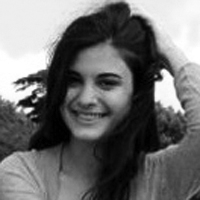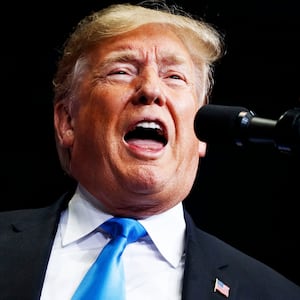For all the increased media attention on immigration—ICE injustices, separated families, and Donald Trump’s racist and xenophobic rhetoric—there are thousands of stories that aren’t being told. Out of Many, One, a new Netflix documentary short, sets out to make a small dent in those stories. The film, directed by John Hoffman and Nanfu Wang, approaches the topic through the Citizenship Project, a program designed to help green card holders prepare for their citizenship exams.
In the midst of a deeply inhumane national conversation around immigration, and what feels like a daily litany of atrocities, Out of Many, One offers a purposefully humanistic approach. While the short is ostensibly about the Citizenship Project’s classes, and is bookended by triumphant footage from naturalization ceremonies, it’s really a vehicle for a handful of personal testimonies. Their names are Dipna Cordova, Fanny Bello, Jian Zhang and Alexandra and Dagoberto Aristizabal.
We’re first introduced to these protagonists in their own words, as they introduce themselves to their fellow citizenship applicants. Each student is asked to share their reason for enrolling in the program. “It’s time to be a citizen because we love this country, and we are scared about the future,” Alexandra Aristizabal explains. “So we can vote, we can have the rights, we can have the voice, we can count.”
The New York Historical Society created the Citizenship Project in January 2017 in response to changing laws around U.S. immigration. A 2017 New York Times piece explained that, “The historical society’s leadership decided to take an active role in helping permanent residents become citizens after President Trump in January called for travel restrictions on Muslims entering the United States. The classes started in July, and the historical society has a goal of helping 750 to 1,000 people prepare for the citizenship exam. The project is a 32-hour interactive program that uses artifacts, documents and art from the museum’s permanent collection and covers all the questions used in the test.”
Throughout the film, Samantha Rijkers, the manager of the Citizenship Project, can be seen leading her students through the Historical Society’s gallery, as well as in more typical classroom settings. Out of Many, One chooses to highlight group discussions about slavery, anti-immigrant sentiment, and the forcible removal of Native Americans, implying that the naturalization test does not shy away from the ugliest moments in American history. “I think the United States government decided to include questions about slavery, about the Civil War, because that is American history,” Rijkers opines. “And if you don’t understand the past, and you want to become a part of this country, you don’t understand the present.” At one point, the group studies a political cartoon that depicts the building of an anti-Chinese “wall.” “That’s the same as today, they’re going to put a wall in Mexico,” one of the students remarks. The group murmurs their assent, and acknowledges that history often repeats itself.
Reflecting on a discussion about the civil rights movement, Jian Zhang remarks, “America has its shortcomings. However, America’s political system, belief system, are trying to overcome these shortcomings. Its political system is moving towards the right direction.” His fellow student, Dagoberto Aristizabal, has a slightly darker reading: “For things to move forward and get better, someone has to suffer.”
Against footage from their life in New York, Dagoberto and his wife Alexandra narrate their decades-long journey to citizenship. After 9/11, Dagoberto, who used to travel back and forth to Colombia with tourist visas, explains, “They became stricter with immigration laws. So I thought, I’m not going back anymore.”
“It was a slow and difficult process to get our papers,” Alexandra adds. “We went to the lawyer’s office, that case cost us 30-some thousand dollars, because they announced in the news that the immigration fees were going up. They took advantage of us.” Still, she continues, “You come here, you get settled, you learn to love this country.”
“To become a citizen you need to love this country, and we do,” she concludes. “We’ve contributed and we’ve done things how they should be done.” The Aristizabal’s contributions included working to clean up Ground Zero in the aftermath of the 9/11 attacks. “There always has to be someone who does the work that they don’t want to do,” Dagoberto offers. “My boss told me, OK, we have to go and clean the Twin Towers. We didn’t know what had happened.”
Dagoberto was there for one year, and Alexandra worked at the site for three months. “We were caught up in having work and being useful,” Alexandra explains. Dagoberto developed asthma, and the Aristizabals feared that the clean-up could further impact their health in the future. “We can die, and isn’t that dying for this country?” Alexandra asks. “To help with that tragedy? We want to become citizens because we think that we’ve earned that right.”
Fanny Bello’s story began in Venezuela, where she worked herself up from a typist for the Minister of Agriculture. “Everything changed when a tyrant ruined the economy of the country,” Bello narrates. A critic of Hugo Chávez, Bello risked her life by writing a book about “the political, social, economic, and moral situation in Venezuela.” Now, she calls it “the book that almost got me hanged.” Bello explains, “That was the tipping point because the police came after me, and it was a truly terrible moment.”
“They arrived in the morning with guns in their hands, and then the gun was at my head. They broke my computer, threw me to the ground, tied me up and killed my dog. They said they were doing this to stop me from publishing propaganda… I had to leave the country.” Bello was granted political asylum, and promises, “I am fighting now, and I will fight when I become a citizen. Fighting to set Venezuela free from the present tyranny.” The documentary follows her to a rally in Union Square, where she proudly waves a Venezuelan flag.
Like the Citizenship Project itself, these aspiring citizens are responding to the fear and uncertainty of Trump’s immigration policies and rhetoric. At times, they are quite candid about this perceived urgency. “The immigration situation is getting harder, and the things that many are telling us are starting to scare us,” Alexandra Aristizabal confesses. “We are very afraid that the person who is leading us now could lead us to something terrible.”
Dipna Cordova was also impacted by changes after 9/11; where before she could come and go, her tourist visa “no longer functioned… so that’s when I decided to no longer leave this country.” Her son petitioned for her residency when he turned 21. “Sometimes I have felt frustrated by some people’s attitudes,” Cordova admits. “Recently, someone told me to stop speaking Spanish. They said we shouldn’t speak Spanish on the bus… It’s a very difficult experience. You have to be really strong. You learn how to leave your loneliness aside and push yourself to try to get ahead for your sons.”
“Despite what’s happening now, I think there are many good people who want change. They say that after the darkness comes the dawn.”
With few illusions about America’s complicated past, terrifying present and uncertain future, the Citizen Project students are still unwavering in their commitment to this country, frequently expressing their love and gratitude. Out of Many, One is unabashedly cheery and sentimental, framed by footage of Supreme Court Justice Ruth Bader Ginsburg presiding over a naturalization ceremony at the New York Historical Society. “We are a nation made strong by people like you, people who have traveled long distances, overcome great obstacles, all to provide a better life for themselves and their families,” she intones, to a crowd of newly-minted citizens waving hand-held American flags. “May the spirit of liberty be your beacon as you play your part in helping to achieve a more perfect union.”







